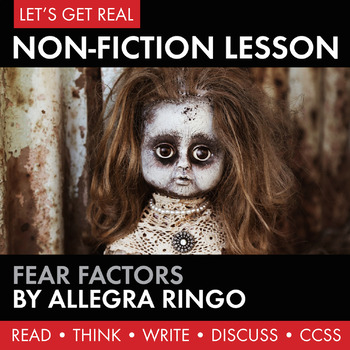Expository, Non-Fiction Lesson on Modern Issues: Fear Factors, Grades 8-12, CCSS
- PDF
What educators are saying
Description
The Common Core has a much-greater focus on non-fiction, informational texts in the English/Language Arts classroom. It’s time to start adding more real-world articles and materials to our literary canon. In this easy-to-deliver non-fiction activity, students will read an interview-based article by Allegra Ringo (link included) and complete a series of deep-thinking questions. Afterward, students will definitely have personal opinions to share about this “Let’s Get Real” classroom activity.
When your principal asks what you’ve done to align your classroom with the Common Core, just point to this non-fiction, expository-based work as an example. This 45-minute lesson will give students a high-quality article to analyze as they make connections between the work and their own lives.
In this article, Ringo profiles Dr. Margee Kerr, a sociologist who specializes in studying why some people enjoy being scared more than others. The text-based questions will engage your students as they dig back into the article and use their critical analysis skills to find the answers.
Begin with a reading of the article (either aloud or solo), have individuals write their answers to the multi-layered depth-of-knowledge questions (either in teams of two or solo), and then launch a class discussion.
This package includes an option for 9th and 10th graders and separate questions for 11th and 12th graders. The article is the same for both groups, but the reflection questions are different, so that various levels of students will find the activity stimulating and challenging. Advanced middle school students should be able to successfully work with the “Level 1” questions, too.
Both sets of questions come with detailed answer keys, of course. You might also want to use the two separate question sheets for differentiated questions within one class.
It usually takes my students 45 minutes to work through the article, give thorough answers to the questions, and discuss the issues raised in the article. Your students will have plenty of reactions to Ringo’s article that they’ll want to share.
These full-class, stand-alone materials also work great as a supplement lesson for any study of works by Edgar Allan Poe/Dark Romantic writers and/or as emergency plans for substitute teachers. The material is easy to deliver and the kids will need to work hard for the whole period to finish on time.
Want a similar assignment with a different topic? You can look through all of my non-fiction lessons here:
https://www.teacherspayteachers.com/Store/Laura-Randazzo/Category/Non-Fiction-47646
NOTE: This item is included in my English 9-10 full-year curriculum. If you already own the full-year download, please do not purchase this item here individually. If you’d like to receive this item plus everything else needed to teach 180 days of English 9 or English 10 at a deeply discounted price, click here to learn more about the full-year curriculum download.
Thanks for stopping by!





